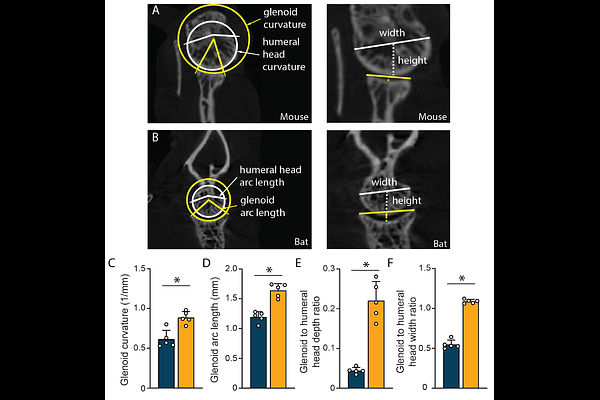Musculoskeletal architecture of the shoulder: A comparative anatomy study in bats and mice informing human rotator cuff function

Musculoskeletal architecture of the shoulder: A comparative anatomy study in bats and mice informing human rotator cuff function
Kurtaliaj, I.; Kunes, J.; Li, S.; Rowley, M.; Forrester, L. A.; Golman, M.; Swartz, S. M.; Levine, W. N.; Genin, G. M.; Thomopoulos, S.
AbstractOverhead motion in humans often leads to shoulder injuries, a consequence of the evolutionary trade-off in glenohumeral joint anatomy that balances stability with mobility. Bats consistently engage in overhead motion during flight, subjecting their shoulders to substantial loading throughout their relatively long lifespan. Remarkably, despite the demands placed on a bat\'s shoulder, instability and rotator cuff tears, which could be fatal to bats in short order, are not observed in nature. We were thus inspired to study functional adaptations in the shoulders of bats that enable this overhead motion. Comparative anatomical studies of the shoulders of bats and mice, similarly-sized quadrupeds, were performed and interpreted using a mathematical model. Scapular anatomy indicated a more prominent role for the infraspinatus muscle in the bat compared to the mouse. Measurements of bat and mice shoulders revealed that the bat glenoid had a larger curvature and arc length than that of mice, providing a larger articulating surface area with and deeper enclosing surface of the humeral head. Modeling results predicted that the bat shoulder is stable over a dramatically larger range of angles compared to the mouse shoulder. These results suggested that adaptations to constraints imposed by the bony anatomy and rotator cuff tendons of the shoulder may contribute to the ability of bats to sustain overhead motion in a high stress, repeated loading environment without injury. Results suggest that bats have evolved unique adaptations in their glenohumeral bony anatomy that reduce stress on the supraspinatus, enhance joint stability, and optimize strength across a broad range of motion.